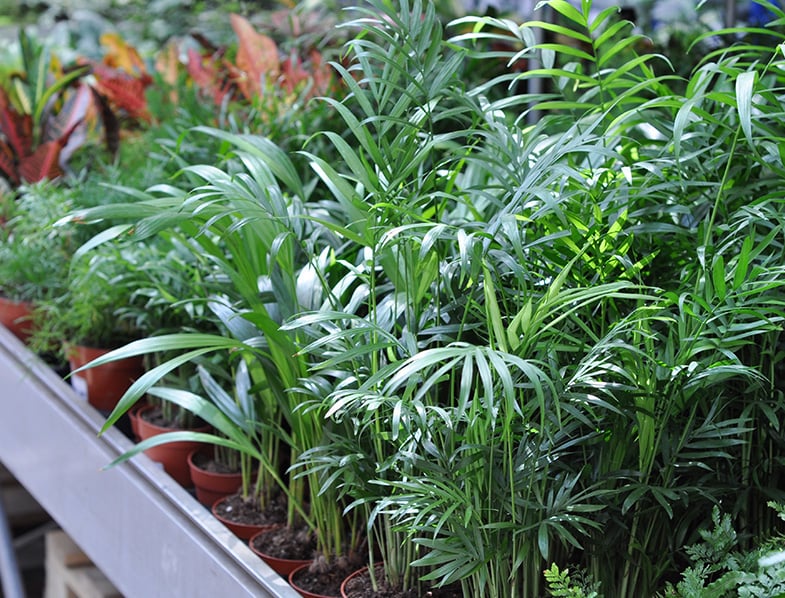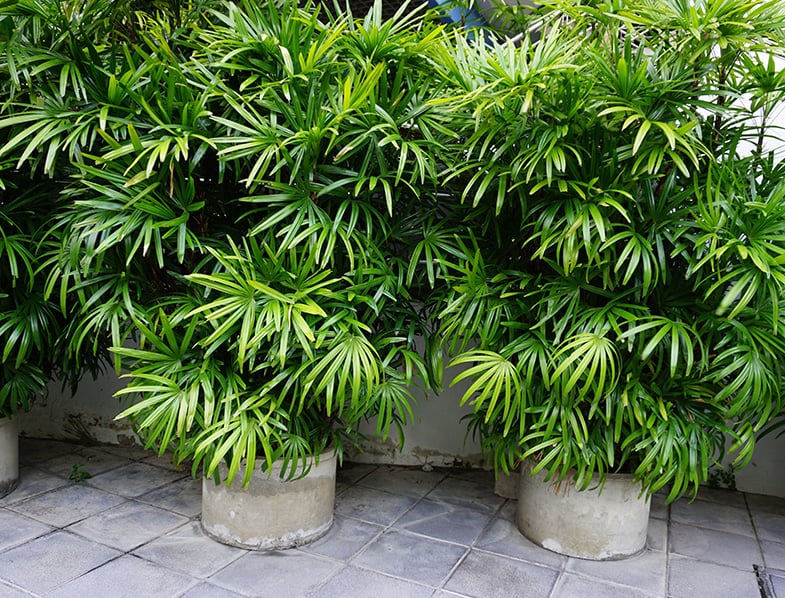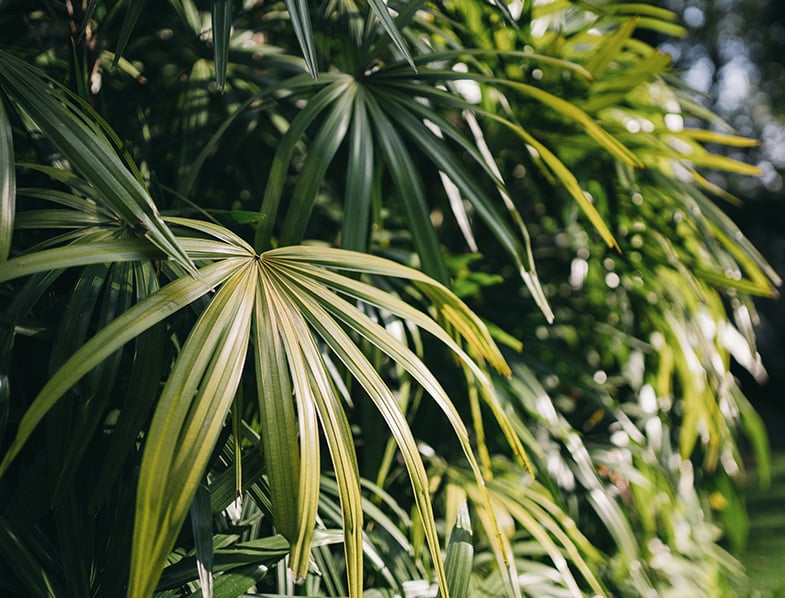Bamboo palms are stunning, graceful plants that can add a touch of nature to any room or outdoor setting. Not only do they look great, but they’re also easy to grow and care for, making them an ideal plant for both beginner and experienced gardeners. In this article, we’ll cover everything you need to know to grow a healthy and thriving bamboo palm in your home or garden. So, let’s get started!
Quick Facts
| Property | Description |
|---|---|
| Common Name | Bamboo Palm |
| Scientific Name | Chamaedorea seifrizii |
| Native To | Rainforests of Central and South America |
| Size | Up to six feet tall |
| Light Requirement | Prefers bright, indirect light but can tolerate lower light conditions |
| Soil Requirement | Well-draining soil, rich in organic matter |
| Watering | Once a week in growing season, once every two weeks otherwise |
| Ideal Soil pH | 6.0 to 6.5 |
| Fertilization | General-purpose fertilizer every few months during growing season |
| Pruning | Regularly remove dead, yellow, or damaged fronds |
| Pests/Diseases | Spider mites, Mealybugs, Root rot |
| Planting Time | Spring or Summer, any time if indoors |
| Benefits | Improves air quality, reduces stress, promotes better sleep |
| Special Features | Can grow in containers or small spaces, air-purifying |
Understanding Bamboo Palms
Bamboo palms, also known by their scientific name Chamaedorea seifrizii, are native to the rainforests of Central and South America. These palms are typically small, growing up to six feet tall, and have slender stems that produce lush, green foliage.
If you’re looking for a plant that’s easy to care for and adds a touch of tropical beauty to your home or office, then bamboo palms might be just what you need. Let’s take a closer look at these fascinating plants and explore their unique features and benefits.
Characteristics of Bamboo Palms
Bamboo palms are known for their unique characteristics, which make them stand out from other palm species. One of their most striking features is their large, bright green fronds, which can grow up to three feet long and are supported by slim, woody stems. These fronds are arranged in a fan-like pattern, making the plant look full and vibrant.
Another interesting feature of bamboo palms is their shallow root system, which means they don’t need a lot of space in order to grow healthy and strong. This makes them ideal for growing in containers or small spaces.
Bamboo palms are also known for their versatility, as they can be grown indoors or outdoors, depending on your preference. They prefer bright, indirect light and well-draining soil, but can tolerate lower light conditions and occasional periods of drought.
Different Types of Bamboo Palms
There are several different types of bamboo palms, each with its own unique characteristics. Here are a few of the most popular varieties:
- Chamaedorea elegans – this is the most commonly grown type of bamboo palm, also known as the Neanthe Bella palm. It grows up to six feet tall and is ideal for indoor use. Its delicate fronds and compact size make it a popular choice for tabletops and shelves.
- Chamaedorea cataractarum – also known as the Cat palm, this variety is slightly taller and has wider leaves. It’s a great choice for outdoor use in warmer climates, where it can grow up to 10 feet tall. Its lush foliage and graceful arching stems make it a favorite among landscapers and gardeners.
- Chamaedorea metallica – this variety has metallic-blue leaves and is ideal for indoor use in low to medium light conditions. Its unusual coloration and compact size make it a popular choice for modern and minimalist interiors.
Benefits of Growing Bamboo Palms
In addition to their aesthetic appeal, bamboo palms also offer several health benefits. These include:
- Improved air quality – bamboo palms are excellent at filtering and purifying the air, removing harmful toxins and pollutants. This makes them a great choice for homes and offices with poor air circulation or high levels of indoor pollution.
- Reduced stress – the presence of greenery has been shown to reduce stress levels and promote a sense of calm. Bamboo palms, with their lush foliage and graceful form, can help create a relaxing and soothing environment.
- Better sleep – plants like bamboo palms can improve indoor air quality, which in turn can help you get a better night’s sleep. They release oxygen and absorb carbon dioxide, creating a healthier and more restful atmosphere.
Whether you’re looking to add a touch of tropical flair to your home or office, or simply want to enjoy the many benefits of indoor plants, bamboo palms are an excellent choice. With their unique features and easy care requirements, they’re sure to bring joy and beauty to your space for years to come.

Preparing to Plant Your Bamboo Palm
Bamboo palms are beautiful plants that can add a touch of tropical elegance to any space. They are relatively easy to grow and care for, as long as you follow a few simple guidelines. In this guide, we’ll take you through the steps of preparing to plant your bamboo palm, from choosing the right location to gathering the necessary tools and materials.
Choosing the Right Location
The first step to successfully growing a bamboo palm is to choose the right location. Whether you’re planning to grow your palm indoors or outdoors, it’s important to select an area that receives the appropriate amount of sunlight and is well-ventilated. Generally, bamboo palms prefer indirect or filtered sunlight, but can tolerate brighter light if given adequate moisture and nutrients.
If you’re growing your palm indoors, select a spot near a window that gets plenty of natural light. Avoid placing your plant near air conditioning vents or drafty windows, as this can cause the leaves to dry out and turn brown. If you’re growing your bamboo palm outdoors, choose a location that is sheltered from strong winds and receives partial shade during the day. This will help to protect your plant from the harsh rays of the sun and prevent it from drying out.
Selecting the Best Soil
Bamboo palms thrive in well-draining soil that is rich in organic matter. In general, a potting mix that contains peat moss, perlite, and/or vermiculite works well for indoor plants, while a soil mix that contains sand and mulch is suitable for outdoor plants. Make sure to choose a soil that is pH-balanced and doesn’t contain any pesticides or chemicals that could harm your plant.
Before planting your bamboo palm, it’s a good idea to test the soil pH to ensure that it’s within the ideal range of 6.0 to 6.5. You can purchase a soil testing kit at your local garden center or online. If the pH is too low, you can add lime to raise it. If it’s too high, you can add sulfur to lower it. This will help to ensure that your plant has the right balance of nutrients to grow and thrive.
Gathering Necessary Tools and Materials
Before planting your bamboo palm, it’s important to gather all the necessary tools and materials. Here are a few items you may need:
- A container (if growing indoors)
- Soil
- Fertilizer
- Gardening gloves
- A watering can or hose
- Pruning shears
- A shovel or trowel (if planting outdoors)
When choosing a container for your indoor bamboo palm, make sure it has drainage holes to allow excess water to escape. You can also add a layer of gravel or stones to the bottom of the container to help with drainage. For outdoor planting, make sure the soil is well-draining and has good aeration to prevent waterlogging.
Once you have all the necessary tools and materials, you’re ready to start planting your bamboo palm. With a little bit of care and attention, your plant will grow into a beautiful and healthy addition to your home or garden.

Planting Your Bamboo Palm
When to Plant Bamboo Palms
The ideal time to plant a bamboo palm is during the spring or summer, when the weather is warm and the plant is actively growing. If you’re growing your palm indoors, you can plant it at any time of the year, as long as the conditions are suitable (i.e. adequate light, temperature, and moisture).
How to Plant Bamboo Palm Seeds
If you’re starting your bamboo palm from seeds, follow these steps:
- Saturate the soil in your container or outdoor planting area with water.
- Place the seeds on top of the soil, spacing them evenly apart.
- Cover the seeds with a thin layer of soil, making sure they are completely covered.
- Water the soil again, making sure it’s moist but not waterlogged.
- Keep the soil consistently moist until the seeds sprout.
Transplanting Bamboo Palm Seedlings
If you’ve purchased a bamboo palm seedling, follow these steps:
- Fill your container or outdoor planting area with soil, leaving enough room to accommodate the root ball of your seedling.
- Remove the seedling from its container and gently loosen the roots.
- Place the seedling in the soil and backfill around it, making sure not to cover the top of the root ball.
- Water the soil thoroughly, making sure it’s moist but not waterlogged.
- Keep the soil consistently moist until the seedling establishes itself.
Caring for Your Bamboo Palm
Watering and Fertilizing
Bamboo palms require consistent moisture to thrive, so it’s important to water them regularly. In general, you should water your plant once a week during the growing season (spring and summer) and once every two weeks during the dormant season (fall and winter). Avoid overwatering, as this can lead to root rot and other problems.
It’s also important to fertilize your bamboo palm periodically, especially if you’re growing it indoors. Use a general-purpose fertilizer diluted to half strength, and apply it every few months during the growing season.
Pruning and Maintenance
Regular pruning is essential for maintaining the health and appearance of your bamboo palm. To prune your plant, simply remove any dead, yellow, or damaged fronds using pruning shears. This will encourage new growth and prevent the spread of disease.
In addition to pruning, you should also remove any dead leaves or debris from around the base of your plant, as this can attract pests and promote fungal growth.
Pest and Disease Control
Bamboo palms are generally resistant to pests and diseases, but they can still be susceptible to certain problems. Here are a few common issues to watch out for:
- Spider mites – small, spider-like creatures that can cause yellow or brown spots on the leaves. Treat with an insecticidal soap or oil.
- Mealybugs – small, white insects that resemble cotton. Treat with rubbing alcohol or a systemic insecticide.
- Root rot – caused by overwatering or poor drainage, this condition can cause the plant to wilt or develop yellow leaves. To prevent, make sure the soil is well-draining and don’t overwater.

Conclusion
Growing a bamboo palm is a fun and rewarding experience, whether you’re a seasoned gardener or just starting out. By following the tips and techniques outlined in this article, you can ensure that your plant stays healthy and vibrant for years to come. So go ahead and give it a try – your home and garden will thank you!
Bamboo Palms FAQS
How long does a bamboo palm take to grow?
The growth rate of a bamboo palm can vary based on its growing conditions, but generally, it’s a relatively slow-growing plant. It can take several years for a bamboo palm to reach its mature height of up to six feet.
Do bamboo palms like sun or shade?
Bamboo palms prefer bright, indirect light. While they can tolerate lower light conditions, they should be protected from direct sunlight as it can burn their leaves. So, they are best suited to places with filtered sunlight or partial shade.
Can you grow bamboo palm from cutting?
Bamboo palms are typically propagated by seeds, not cuttings. Attempting to grow a bamboo palm from a cutting is often unsuccessful. If you want to propagate your palm, it’s best to purchase seeds or a young plant from a nursery.
What conditions do bamboo palms like to grow in?
Bamboo palms enjoy warm, humid conditions similar to their native rainforest habitat. They prefer bright, indirect light and well-draining soil rich in organic matter. The soil pH should be in the range of 6.0 to 6.5. They can tolerate lower light conditions and occasional periods of drought, but they do best when they have consistent moisture and nutrients.
How often should I water my bamboo palm?
Watering frequency for a bamboo palm can depend on its environment. Generally, you should water your palm once a week during the growing season (spring and summer) and once every two weeks during the dormant season (fall and winter). Be sure to avoid overwatering, as this can lead to root rot.
Why is my bamboo palm dying?
There could be several reasons why your bamboo palm is struggling. Overwatering or poor drainage can cause root rot, leading to yellowing leaves and wilting. Similarly, direct sunlight can burn the leaves, causing them to turn brown and dry out. It could also be a result of inadequate nutrients, pests like spider mites or mealybugs, or diseases such as fungal infections. It’s important to diagnose the issue accurately to provide the right treatment. If you’re unsure, it may be best to consult with a local nursery or extension service.
